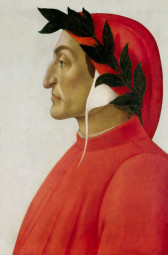Last November, Associate Professor of Musicology Michael Anderson and his Chicago-based vocal ensemble Schola Antiqua contributed music for two important occasions. One was local—the inauguration of Chicago’s Athenaeum Center for Thought and Culture, formerly the Athenaeum Theatre. The other was a global occasion–the 700th anniversary (in 2021) of the death of the great Italian medieval poet Dante Alighieri, a moment of great significance in the literary world, inside and outside his native Italy.
Dante 360, as the show was called, brought together visual imagery, commentary, spoken words, and drama to tell the story of the poet’s most enduring work, the Divina Commedia, or Divine Comedy. Under Anderson’s direction, Schola Antiqua outfitted Dante 360 with its own “soundtrack,” a wide-ranging musical program that took listeners on a sonic journey in the live cross-disciplinary undertaking, complete with local actors staging key scenes from the narrative, projected in another world with heavy use of theater fog. (See the photo below right .)
“I didn’t know if we could pull it off,” he says of the complex project – but fortunately Michael’s most important partner in planning Dante 360 was the art historian Elizabeth Lev – “and what a partner!” Lev is an authority on Italian visual culture and Dante’s Divine Comedy in particular. Her final plan for Dante 360 mirrored the poem’s structure as a journey from Hell to Purgatory to Paradise. Once it was in place, this gave Michael some initial ideas for his musical contribution.
In developing the musical program, Michael encountered some challenges. An obvious choice might be to choose medieval or Renaissance songs and madrigals using texts from Dante, but he soon discovered that there weren’t many of them. “Dante’s poetry uses such a rich, highly rhetorical style that composers were not always eager to set,” he says. His poems were unfolded as canti, already denoting a kind of song. Despite the poem’s religious import and mentions of chant, he did not want to restrict himself to medieval sacred music alone. The overall presentation was designed much more broadly than that.
Just as Dante’s influence was shown in visual art through the centuries, Anderson conceived of a soundtrack echo the emotion that Dante sought to convey, from whatever corner of music history. Some medieval and Renaissance vocal works reflected themes in the Divine Comedy including the prideful seeking humility, unrequited love, and the sighs and screams of the damned. The resulting soundscape included music by Hildegard of Bingen, Luzzasco Luzzaschi, and Luca Marenzio, for example.

To Hell and back: Michael Anderson leading Schola Antiqua out of the fog during Dante 360. Photo by Steven Caldicott Wilson.
But modern music also played a role: a search for “the most hellish piece I could find” to illustrate the depths of the inferno in sound led him to “Anthony O’Daly,” a choral piece by Samuel Barber about the hanging of a 19th-century Irishman. A sumptuous setting of the iconic text Ave Maria, written in 1992 by Javier Busto, captured the bliss coming out of Purgatory with the help of the Virgin Mary.
Giving musical expression to the ultimate goal, admission to Paradise, was also a tricky proposition and, Anderson points out, one that composers have traditionally shied away from. Franz Liszt’s Dante Symphony, for example, only journeys through Hell and Purgatory. As part of the program’s transcendent conclusion, Michael found a beautiful, and very difficult, setting in a post-tonal musical idiom by the Scandinavian composer Lars Edlund, which set a text by Dante.
Taking the listener to the splendid glory of heaven, Anderson finished his program with a much simpler but august musical choice: Frederick Delius’ choral gem “To Be Sung of a Summer Night on the River.” The peaceful music, organized in waves of extravagant harmony, exemplified for many in the audience the inspired representation of the joys of Paradise. Delius specifies no words for the two-minute outpouring of choral sound – the singers perform a “vocalise,” only uttering “ah.” In Anderson’s words, “Speech fails us when we consider the heavens.”

